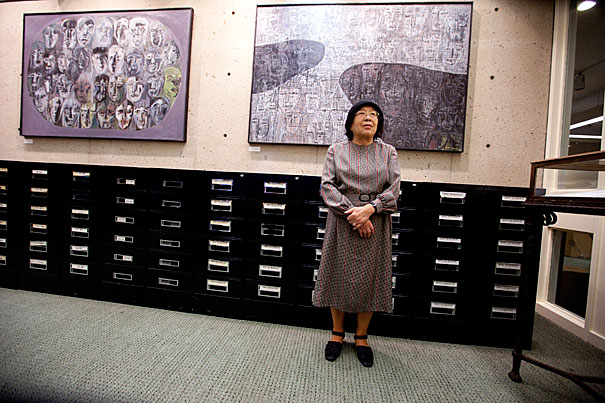
A new exhibition at the Harvard Graduate School of Education’s Monroe C. Gutman Library, “With Hiroshima Eyes: The Hibakusha Art of Junko Kayashige,” depicts a series of evocative images inspired by Kayashige’s experience as a “Hibakusha,” an atomic bomb survivor.
Rose Lincoln/Harvard Staff Photographer
Memories of Armageddon
Artist’s work recalls Hiroshima bombing from ground level
It weighed close to 9,000 pounds, was dubbed “Little Boy,” and exploded about 1,800 feet above Hiroshima on Aug. 6, 1945. The heat of the initial blast rivaled the temperature of the sun’s surface. By some estimates, it killed 100,000 people instantly.
A young girl at the time, artist Junko Kayashige was only a mile from where a U.S. plane dropped the first of two atomic bombs on Japan. She suffered serious burns to her face, neck, and right arm, and lost several members of her family, including two sisters. On Aug. 9, the second bomb fell on Nagasaki, effectively ending World War II.
Sixty-six years later, the artist and activist is showing her work in America for the first time in an effort to ensure such horror is never repeated.
A new exhibition at the Harvard Graduate School of Education’s Monroe C. Gutman Library, “With Hiroshima Eyes: The Hibakusha Art of Junko Kayashige,” depicts a series of evocative images inspired by Kayashige’s experience as a “Hibakusha,” an atomic bomb survivor.
A longtime activist for peace and nuclear disarmament, she writes of her work, “I wanted to depict the foolishness of humans who attempt to solve problems with war and destruction. It is hard for me to revisit and recount my experience, but nuclear weapons are still threatening our lives.”
Joe Gerson, director of programs and national disarmament coordinator for the New England branch of the American Friends Service Committee, the Quaker-based peace and justice organization that supports eliminating nuclear weapons, met Kayashige during a trip to Japan in the 1980s. He helped connect her with the Harvard space, where he hopes her art and message will reach a wider audience.
“We are not really talking about the depths of the destruction of Hiroshima and Nagasaki,” said Gerson, “and what people who lived through it have carried with them all their lives, not only in terms of the constant fear of cancer or other radiation diseases … but also the memories of hell on earth. Imagine a city destroyed in nine seconds.”
During her career, Kayashige, who was a public school art teacher for 38 years, has created works that capture lasting devastation.
The view from an airplane window inspired the show’s chilling image “Faces II.” In the painting, a collection of blurred faces is partially covered in darkness.
“I was looking down on the town underneath my airplane, and I looked at one of the shadows of one of the wings of the airplane … and I was thinking that the pilots on the Enola Gay might have been looking at the same image,” said Kayashige through an interpreter.
The show has strong Harvard connections. Included in the exhibition, along with books about Hiroshima and its survivors and some house tiles that were melted from the blast, is an Easter egg that was delivered to former Harvard Professor Edwin O. Reischauer (for whom Harvard’s Reischauer Institute of Japanese Studies is named) while he served as the U.S. ambassador to Japan in the 1960s. The message on the painted egg calls for ending nuclear weapons tests.
Former Harvard President James Bryant Conant was a member of the interim committee composed of government officials and scientists who advised President Harry Truman on the use of nuclear energy and weaponry. The group recommended using the atomic bomb, if needed.
Lurking just below the surface of many of Kayashige’s works is the haunting subtext of Hiroshima and Nagasaki. Subjects like destruction and mortality inform much of the art on display. One painting evokes Japan’s recent devastating earthquake and tsunami, another reflects the artist’s struggles with aging and her declining health. In “I Cannot Fly,” the feet on an animal-like figure point to the left, while its head looks awkwardly to the right. The picture relates to her two debilitating strokes.
“I wanted to express the feeling of myself,” said Kayashige, “who cannot do anything.”
A mirage and a friend who was dying from cancer inspired the gripping work “Mirage II,” hanging in the library’s main lobby.
“When I was drawing this painting, I was hoping that his death would be a mirage, like something that disappears,” said Kayashige. … That his death would be an illusion.”
Since 2006, the library’s first-floor reading area has acted as an informal gallery space. Begun as a way to help showcase art by students affiliated with the school’s Arts in Education Program, organizers soon included other Harvard artists and eventually those from outside the Harvard community. For the past three years students from the AIE program has served as the library’s art curator and gallery manager, helping plan and coordinate the revolving exhibitions.
“The students have really added a level of professionalism and commitment to these shows,” said library director John Collins. The works of art “enrich our lives in many ways.”
Collins said Kayashige’s pictures offer viewers a compelling story and a vital connection to the period. “We can view this art with a sense of history,” he said, “and with a sense of empathy.”
For Gerson, the works of his longtime friend afford students and the wider Harvard community an important opportunity to “have an intimation of what Hiroshima was about, and some of the life force that endures.”
Kayashige will give a gallery talk Oct. 13 at 5:30 p.m. The exhibit, which is on display through October, will be the last show in the space before the library undergoes renovation for several months.




